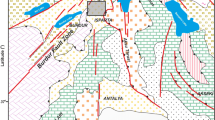Abstract
The Sterea Hellas (central Greece) gravity network was remeasured in 1982, with the addition of 40 new stations. There were no statistically significant gravity differences for most of the gravity stations first established in 1968, but four stations—Arta, Preveza, Levadia, and Kymi—exhibited gravity changes of −121, −74, −39, and −67 μgal, respectively.
In the absence of repeat levelling, the exact amount of vertical displacement cannot be determined. Nevertheless, for Arta and Preveza some theoretical estimates can be made from shallow seismicity data. The vertical displacement deduced from a seismic-moment calculation for the western part of Greece was found to be about 100 mm, corresponding to a slip rate of approximately 7.5 mm/yr. The corresponding gravity change is too small to account fully for that observed at Arta and Preveza. For the rest, other causes, such as creep, should be considered. For the stations Kymi and Levadia the local seismicity is limited, and no calculation was made of the vertical displacement related to earthquakes.
Finally, the possibilities in using the central Greece gravity network for studies of earthquake prediction are discussed.
Similar content being viewed by others
References
Bomford, G. (1971),Geodesy, Oxford University Press, 3rd ed., 239 pp.
Brune, J. N. (1968),Seismic moment, seismicity, and rate of slip along major fault zones, J. Geophys. Res.73, 2, 777–784.
Cartwright, D. E. andEdden, A. C. (1973),Corrected tables of tidal harmonics, Geophys. J. R. astr. Soc.33, 253–264.
Cartwright, D. E. andTayler, R. J. (1971),New computations of the tide-generating potential, Geophys. J. R. astr. Soc.23, 45–74.
Georgadas, D. andLagios, E. (1982),Remeasurement of the national gravity base station network in Peloponnese, Ann. Geol. Pays Hellen.31, 136–145.
Chen, Y. T., Gu, H. D. andLu, Z. X. (1979),Variations of gravity before and after the Haicheng earthquake, 1975, and the Tangshan earthquake, Phys. Earth Plan. Inter.18, 330–338.
Comninakis, P. E. andPapazachos, B. C. (1978),A catalogue of earthquakes in the Mediterranean and and the surrounding area for the period 1901–1975, Geophys. Lab. Thessaloniki Univ., Publ. No. 5, 96 pp.
Hagiwara, Y., Tajima, H., Izutnya, S. andHanada, H. (1979),Gravity change associated with earthquake swarm activities in the eastern part of the Izu peninsula, Bull. Earthquake Res. Inst., Tokyo Univ.52, 141–150.
Kisslinger, G. (1975),Processes during the Matsushiro, Japan, earthquake swarm as revealed by levelling. gravity and spring-flow observations, Geology,3, 57–62.
Lagios, E., Delibasis, N., Drakopoulos, J. andKouskouna, V. (1984),Gravimetric and seismological studies in the Atalanti Fault Zone, Proc. 2nd Hellen. Geol. Symp., Athens, Greece (in press).
Lagios, E. andHipkin, R. G. (1980),Least-squares gravity base station network adjustment, Geophys. Dept. Edinburgh Univ., Publ. No. 80-82, 29 pp.
Lagios, E. andWyss, M. (1983),Estimates of vertical crustal movements along the coast of Greece, based on mean sea level data, Pure and Appl. Geophys.121, 5/6, 867–887.
Lyness, D. (1984),A study of high precision gravimetry, Ph.D. thesis, University of Edinburgh, U. K., 185 pp.
Lyness, D. andLagios, E. (1984),A microgravimetric network in East Central Greece—An area of potential seismic hazard, Geophys. J. R. astr. Soc.77, 785–882.
Main, I. G. andBurton, P. W. (1984),Physical links between crustal deformation, seismic moment and seismic hazard for regions of varying seismicity, Geophys. J. R. astr. Soc.79, 469–488.
Makropoulos, K. (1978),The statistics of large earthquake magnitude and an evaluation of Greek seismicity, Ph.D. thesis, University of Edinburgh, U.K., 193 pp.
Makropoulos, K. personal communication.
Reilinger, R. andBrown, L. (1981),Neotectonic deformation, near surface movements and systematic errors in U. S. relevelling measurements. In: Earthquake Prediction (D. W. Simpson and P. G. Richards, eds.), Maurice Ewing Ser., Vol. 4, A.G.U.
Rundle, J. B. (1978),Gravity changes and the Palmdale bulge, Geophys. Res. Letters,5, 41–44.
Scholz, C. H., Sykes, L. R. andAggarwal, Y. P. (1973),Earthquake prediction: A physical basis, Science181, 803–809.
Torge, W. andKanngieser, E. (1980),Gravity and height variations during the present rifting episode in N. Iceland, J. Geophysics47, 125–131.
Whitcomb, J. M., Franzen, W. O., Given, J. W., Pechmann, J. C. andRuff, L. J. (1980),Time-dependent gravity in southern California, May 1974 to April 1979. J. Geophys. Res.85, 4363–4373.
Wyss, M. andBrune, J. N. (1968),Seismic moment, stress and source dimensions for earthquakes in the California—Nevada region, J. Geophys. Res.73, 4681–4694.
Author information
Authors and Affiliations
Rights and permissions
About this article
Cite this article
Lagios, E. A gravity network in central Greece for secular gravity studies. PAGEOPH 123, 81–90 (1985). https://doi.org/10.1007/BF00877050
Received:
Revised:
Accepted:
Issue Date:
DOI: https://doi.org/10.1007/BF00877050




